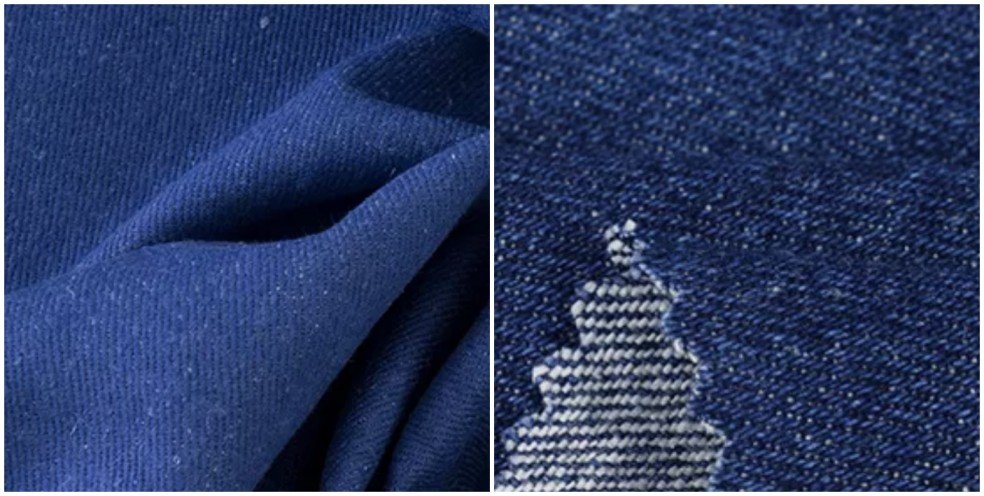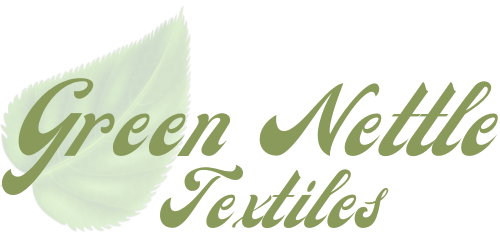Denim is often thought to be synonymous with jeans. There is a connection between these two distinct fabric types; one is a source fabric, and the other is a product fabric. Denim is a sturdy cotton fabric, while Jeans are a type of garment made from denim fabric.
The global denim industry’s forecasted expansion is at a CAGR of around 4.8% between 2022 and 2026, with a market value growth from $57.3 billion to $76.1 billion.
Although you can create jeans from other fabrics, “Denim” is the fabric most commonly used to create jeans. It’s safe to conclude that “jeans” is one clothing item that popularized denim fabric.
Fabric Texture

Denim material is sometimes produced with elastane and stretch added or probably by combining cotton and polyester, a popular choice among manufacturers.
Because denim is woven using the warp-faced twill process, one side of the fabric is dominated by blue warp threads, while white weft threads dominate the other.
The twill pattern and the slubs in the fabric contribute to the cloth’s stronger and less yielding texture.
Nevertheless, the twill-weave pattern that is used in jeans determines the structure and texture of the fabric, and this design requires three warp threads for every single weft thread.
Since denim is the material most commonly used to construct jeans, the garment’s interior is almost always white. Even though both fabrics are constructed using different methods, they have comparable structures and textures.
Production Process

Denim is a twill fabric because its production involves weaving with multiple weft passes for each warp. This pattern gives the fabric a distinctive texture, and this particular method results in distinctive diagonal weaving.
Denim fabric is characterized by its blue warp yarn on the front of the cloth, while its white weft yarn is always found on the back. On the other hand, Jeans is an easy fabric to dye and may be colored in various ways.

Denim is woven with a three-twist pattern, incorporating alternating colors in the warp and weft threads. Despite this, the warp thread will go over the first two weft threads, cross them, and then tuck itself beneath the third weft thread.
Jeans are produced the same way as denim fabric, but the difference lies in the post-production stages.
Creating a natural vintage look using jeans that have been distressed by hand is quite a popular trend. This technique uses various materials to achieve the desired effect, including sand, stones, Dremel tools, and even potassium acid.
Cost of Production
Denim, which is made of cotton, is not an incredibly expensive fabric. High-quality cotton accounts for expensive jeans, whereas synthetic blends are standard in cheaper versions.
Of course, if designers must put more time and care into the stitching and distressing process, that would typically raise the price of jeans.
Cheaper manufacturers typically aim for a more boxy fit, while more expensive ones try to create a more flattering fabric that silhouettes the individual. Looking at this fact, there could be an increase in cost.
Denim might not cost excessively as other fabrics, probably due to its manufacturing process involving cotton and how it is produced.
However, since it is frequently a source material for jeans, that might explain why jeans are a bit pricier than denim fabric if you consider the extra processes involved in producing jeans from denim fabric.
Applications
Denim is a versatile fashion fabric, and jeans are only one of the numerous items you can craft from it. Denim is not the only fabric manufacturers use to construct jeans; nonetheless, it is by far the most common and well-known.
Denim is a popular fabric choice for jeans, jackets, shirts, bags, purses, and other accessories for men and women, boys and girls. Denim has a more casual and laid-back vibe due to its thicker construction.
Denim isn’t just for jeans anymore; it’s now used to make a wide range of skirts, pants, and shorts, as well as caps, belts, handbags, rucksacks, sunglasses, and other accessories.
Denim fabrics are versatile and can be used to create things like upholstery, car seat covers, and other accessories.
Care and Maintenance
Since Denim fabric is used to produce jeans, we can deduce that they’ll pretty much have the same method of care and maintenance.
Some of their care and maintenance tips include:
- Fabric specialists recommend not to machine wash denim fabric because it has a short lifespan and is likely to cause wear and tear, not to mention the hastened dye loss and fading that will result.
- In this case, you should hand-wash them by flipping the inside of the fabric. Because the indigo dye is applied to the outside fibers only, the color lasts longer.
- You may give your denim or jeans a good wash every four to six weeks or more often if they are particularly dirty or stinky.
- It’s also okay to hang them up to dry rather than squeezing off the excess moisture.
Is Denim Just Blue Jeans?

No, denim isn’t just blue jeans. Denim fabrics are available in a wide range of colors, and blue jeans are denim fabrics dyed into that shade. Blue jeans are by far the most well-liked type of jeans, even though there are many colors to choose from.
Either denim available in the blue shade is used to produce blue jeans, or denim is used to produce jeans but is dyed afterward.
One can easily distinguish blue jeans by their colored warp threads and white weft threads. Because the fabric is woven using the warp-faced twill technique, one side of the cloth is dominated by blue warp threads, and white weft threads dominate the other. Because of this, the interior of jeans constructed from this fabric is often reasonably white.
Why is denim so popular?
The longevity of denim clothes is a significant factor in their continued popularity. Denim’s use in jeans results from evolution over the years and the need to create a thick fabric type that everyone loves.
Also, denim’s incorporation into new pant silhouettes from fashion designers worldwide is another indication of the fabric’s popularity.
Denim has also become a symbol of America and the developed world. In contrast, it no longer has the “bad boy” allure it once did; Now, it is connected with the luxury of the modern industrial age, with its transient fashions and rapidly expanding international riches.
